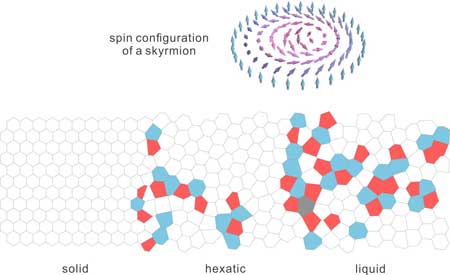| Jun 15, 2020 | |
Melting a crystal topologically(Nanowerk News) The introduction of topology, a branch of mathematics focusing on the properties of “knots”, into physics has inspired revolutionary concepts such as topological phases of matter and topological phase transitions, which results in the Nobel Prize in Physics in 2016. |
|
| Magnetic skyrmions, spin “nano-tornados” named after particle physicist T. Skyrme with unique topology (i.e. winding configurations, Fig. below), have been attracting sharply increasing attentions in the last decade due both to their importance in fundamental physics and their promising applications in the next generation magnetic storage. | |
 |
|
| Upper panel: spin configuration of a skyrmion. Lower panel: Voronoi tessellation of representative skyrmion lattice configurations in the solid, the hexatic and the liquid phases respectively. (Image: Huang Ping, XJTU) | |
| These nano-tornados, also known as quasi-particles (in contrast with real-matter particles like atoms and electrons), can form crystalline structures, that is, they arrange in a periodic and symmetric manner, the same way as atoms in a quartz crystal. | |
| From experiences of everyday life, we are aware that a crystalline solid, such as ice, can melt upon heating. One may also have noted that all such melting transitions happen in a single step, i.e. from the solid state directly to the liquid state. | |
| In the framework of topological phase transition in a very thin crystal, however, a melting process may take two steps, via a topological phase called the hexatic phase. How does such a topological phase look like, and how does this melting process happen? | |
| Now, EPFL physicists have found a way to visualize the whole melting process, as reported recently in Nature Nanotechnology ("Melting of a skyrmion lattice to a skyrmion liquid via a hexatic phase"). | |
| Researchers from Laboratory for Quantum Magnetism (LQM), Laboratory for Ultrafast Microscopy and Electron Scattering (LUMES), Centre Interdisciplinaire de Microscopie Électronique (CIME) and Crystal Growth Facility have demonstrated that the skyrmion crystals in the compound Cu2OSeO3 can be melted by varying magnetic field through two steps, with each step associated with a specific type of topological defects. | |
| The researchers used a state-of-the-art technique called Lorentz Transmission Electron Microscopy (LTEM) that can image magnetic textures in nanometric resolution to visualize skyrmions embedded in a very thin slab of Cu2OSeO3 crystal at -250 degree Celsius. They recorded massive images and videos when varying the magnetic field. By comprehensive quantitative analysis, two novel phases, the skyrmion hexatic phase and the skyrmion liquid phase, have been demonstrated. New phases of matter often bear the opportunities of novel functionalities, and this work, by clearly viewing them, paves the way of further R&D. |
| Source: EPFL | |
|
Subscribe to a free copy of one of our daily Nanowerk Newsletter Email Digests with a compilation of all of the day's news. |
